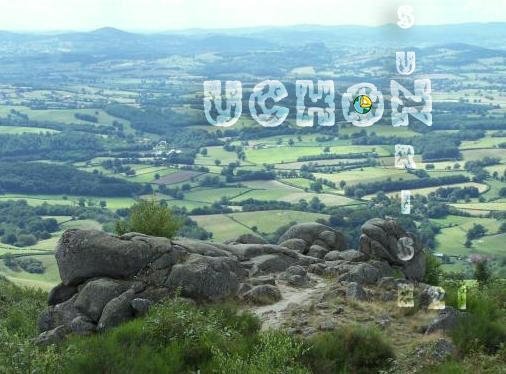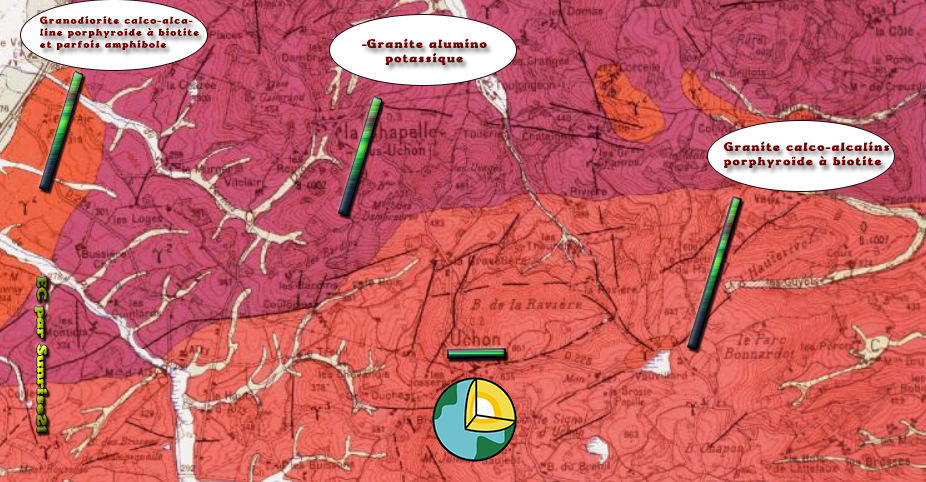UCHON


L’artiste Henry Vincenot à propos du Morvan : "Terres acides et froides, un morceau du pire massif Armoricain"
Uchon, surnommé La Perle du morvan, possède du caractère de par sa situation unique. Si vous parcourez ce territoire, vous rencontrerz le calme à travers les nombreux étangs entourés de forêts de feuillus, mais aussi la puissance à travers cette fois ses chaos granitiques impressionnants.
Artist Henry Vincenot about the Morvan: "Acid and cold lands, a piece of the worst Armorican massif"
Uchon, nicknamed The Pearl of the Morvan, has character by its unique situation. If you roam this territory, you will encounter calm through the many ponds surrounded by deciduous forests, but also the power through this time its impressive granite chaos.
La Griffe du Diable est un chaos granitique qui a stimulé de nombreux esprits de par ses formes et son équilibre particulier. Dans les faits, il s’agit du résultat du processus d’altération du granite. En effet, pour expliquer le passage d’un granite qui a subi des diaclases à l’arénisation en sous sol à un chaos rocheux, il faut chercher du côté des nombreux mouvements tectoniques datant de 20 Ma qui ont surelevé l’ensemble de la région. Puis le climat frais et très pluvieux a continué à éroder la région en transportant le sable granitique dans les cours d’eau d’autrefois. Les arenes se sont dégagées, ce qui a permis au cœur des boules de granit d’emerger. Puis, à l’air libre, les roches sont exposées aux eaux qui ruissellent.

Le granite, du latin granum = grain, par rapport à son aspect visuel, est une roche magmatique plutonique, formée par le refroidissement lent, en profondeur, d'un magma issu de la fusion partielle de la croûte continentale. Le granite est formé de minéraux en grains (cristaux subautomorphes) tous visibles à l'œil nu ; principalement des micas (biotite ou muscovite), des feldspaths potassiques (orthoses) et des plagioclases, noyés dans du quartz xénomorphe (qui empli les vides interstitiels, en effet, le quartz est le dernier minéral à cristalliser lors du refroidissement des masses granitiques).
Arénisation (n. f.) du latin arena, sable ; en anglais granular desintegration : Altération des roches granitiques ou gneissiques, due au contact permanent des eaux de lessivage et conduisant à la formation d'une arène, par désagrégation des feldspaths et altération des micas. Ce phénomène se produit sous la surface
Une hydrolyse (du grec hydro : eau et lysis : briser) est une réaction chimique dans laquelle une liaison covalente est rompue par action d'une molécule d'eau.
Chaos granitique, ou plus généralement chaos rocheux (en anglais, boulder field) (chaos = confusion en grec). Il s'agit d'un entassement désordonné de rochers.
Les chaos granitiques sont le résultat de l'altération en boules des granites, boules qui sont dégagées par l'érosion…
The Devil's Claw is a granitic chaos that has stimulated many spirits by its forms and its particular balance.
In fact, it is the result of the process of alteration of granite. Indeed, to explain the passage from a granite that has undergone deaillases to arenization in the basement to a rocky chaos, we must look for the many tectonic movements dating back to 20 Ma have, which have elevated the whole of the region. Then the cool and very rainy climate continued to erode the area by carrying granite sand into the rivers of yesteryear. The arenes were cleared, which allowed the heart of the granite balls to emerge. Then, in the open air, the rocks are exposed to the streaming water, forming the traces of "claws" of this rock
Granite, from the Latin granum = grain, in relation to its visual appearance, is a plutonic magma rock, formed by the slow, deep cooling of a magma resulting from the partial melting of the continental crust. Granite is formed of granular minerals (subautomorphic crystals) all visible to the naked eye; mainly micas (biotite or muscovite), potassium feldspars (orthoses) and plagioclases, embedded in xenomorphous quartz (which fills the interstitial voids, in fact, quartz is the last mineral to crystallize during the cooling of the granite masses).

Arenization (No. f.) Of the Latin arena, sand; in English granular disintegration: Alteration of granitic or gneissic rocks, due to permanent contact of the water of leaching and leading to the formation of an arena, by disintegration of feldspars and alteration of micas. This phenomenon occurs under the surface
Hydrolysis (from the Greek hydro: water and lysis: breaking) is a chemical reaction in which a covalent bond is broken by the action of a molecule of water.
Granitic chaos, or more generally boulder field (chaos = confusion in Greek). It is a disorderly pile of rocks.
Source : http://paysage.parcdumorvan.org/
www.patrimoinedumorvan.org/
http://www.geoforum.fr/
http://www.geowiki.fr
infoterre.brgm.fr
Cours de Geologie (Licence) dispensé à l'Université de Bourgogne |
Rappel concernant les « Earthcaches »: Il n'y a pas de conteneur à rechercher ni de logbook à renseigner. Il suffit de se rendre sur les lieux et d'éxécuter les requêtes du geocacheur.
Loguez cette cache "Found it" et envoyez-moi vos propositions de réponses soit via mon profil, soit via la messagerie geocaching.com (Message Center), EN PRECISANT LE NOM ET CODE GC DE LA CACHE et je vous contacterai en cas de problème.
Il est aussi apprécié d'avoir des photos des géocacheurs sur les lieux de l''EarthCache. Sentez vous inspiré de poster des photos de vous lors de cette visite ( optionnelle mais sympathique)
---
Reminder concerning "Earthcaches": there is neither a container to look for nor a logbook to sign.
Log in this cache " Found it " and send me your answers proposals or via my profile or via geocaching.com messaging (Message Center ) , BY PROVIDING THE NAME AND GC CODE OF THE CACHE and I will contact you in case of problems .
We also enjoy seeing photographs of people visiting this EarthCache. Please feel free to log photos of your visit...(this is entirely optional but funny)
Grace à la lecture du descriptif et votre observation, répondez aux questions suivantes :
Thanks to the reading of the description and your observation, answer the following questions:
Q7a- D’après le descriptif et vos observations, à quoi correspondent les griffes de la roche ?
Q7b Quelles en sont l’origine ?
Q8 Comment voyez vous l’érosion interne qu’a subi la roche ?
Q7a- According to the description and your observations, what are the claws of the rock?
Q7b What are the origins?
Q8 How do you see the internal erosion suffered by the rock?